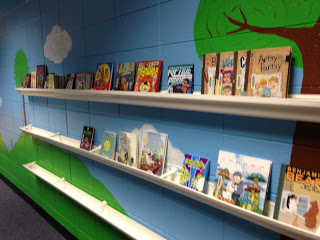I believe that school libraries should be the center - symbolic, if not physical - of the school. Schools are places of learning, and libraries are repositories of the learning of all mankind. Of course, access to that learning has changed tremendously in the decades since I graduated from high school (Dike High School, Class of 1988). And yet, libraries still serve an important function in our schools.
One thing that I've done in my time at Manson Northwest Webster Schools is to work to create Learning Commons environments at both the elementary and secondary centers. This week at the Barnum center, third graders came into the library and used the space as an extension of their classroom as they did their Daily Five literacy stations. Also this week, students brought their parents into the library after their conferences were done, to proudly show them the many changes that we made this summer. Our guidance counselor, Pam Bleam, said, "The changes to the library make me ask, 'Why didn't we do this twenty years ago?' It's hard to believe what paint, talent, rearranging, and fresh new energy can do to a familiar space." It really is true. We're not done yet, either - my associate, Donna, and I are looking at genrefying the fiction, and bookstore-modeling the nonfiction. Next summer! (Granted, we are blessed with a generous gift from a benefactor, and a tremendously supportive administration.)
Changes at the high school are no less exciting. In fact, it was the library in Manson that was first tackled. What has happened since, though, is more exciting - students come in to the library each period to study, to collaborate, to relax, to talk about the latest game or current events. That reminds me - I need to count students! I'm sure, though, that we've gone from about fifteen students a day at the beginning of last year to over a hundred these days. Mondays often find students coming in, checking out new books or magazines. There will be even bigger changes soon as the FCCLA makes the finishing touches on - what used to be my office - a coffee bar, once a week serving not just flavored coffees, but breakfast pizza, cinnamon rolls, smoothies, and more.
Another thing I think we need to do as teacher librarians is to reach out to new teachers. If elected as IASL vice-president/president-elect, I will reach out to our teacher education programs across the state and seek to put teacher librarians on their radar. When I was in UNI's 2+2 program not too long ago (I was a non-traditional student), there were many opportunities for collaboration with teacher librarians, although it seemed I was the one, as a student, who repeatedly mentioned that. I had several professors who, when pressed, sort of romanticized teacher librarians, as if we belong to some idealized past. Perhaps we are part of their memories - which is great! - but we must be part of their realities, too. Teacher education programs have a lot to focus on, yes, but I believe teacher librarians can help.
At any rate, one thing that I've done at MNW is to hold "Lunch 'n Learns" (last year) and now "Teacher Investigations," both dedicated time in the library for new and seasoned teachers to learn about new technology, to share what is working in their rooms, and to help each other in educating the children at our school. This is exactly the vision I have for Iowa's teacher librarians. I know I already do this through Twitter, through reading librarians' blogs, through the IASL convention - learn about new technology and ideas, share what is working at my library, and, with other teacher librarians, work together to educate the children of Iowa's schools.
It's so easy as a teacher librarian to feel isolated, but it doesn't have to be. IASL is there to help.
I humbly ask for your vote as IASL vice president/president-
Thanks!


















































